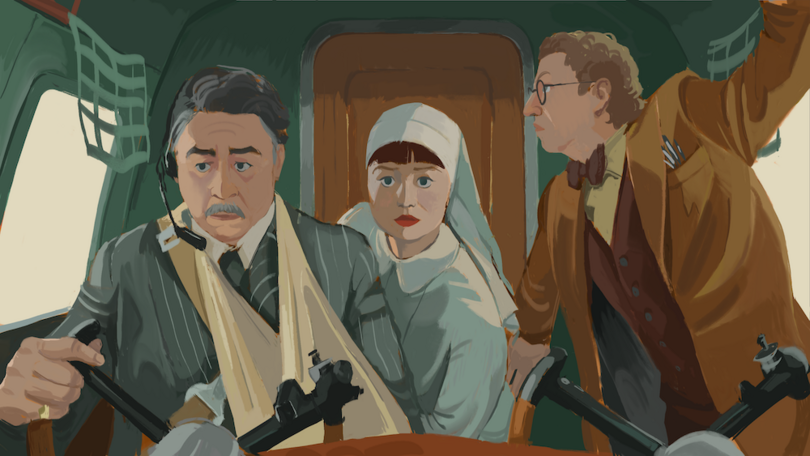‘The Phoenician Scheme’ embraces vibrant aesthetic to grapple with heavy themes

“The Phoenician Scheme” signifies a new era of Wes Anderson films, one that reflects the creative freedom and risk-taking of a veteran director, our columnist says. This, however, can come at the cost of strong, carefully constructed plots. Julia Rodenberger | Contributing Illustrator
Get the latest Syracuse news delivered right to your inbox.
Subscribe to our newsletter here.
Symmetry, vibrant colors, quirky characters, offbeat humor and of course, Bill Murray, are the true staples of a Wes Anderson picture. His latest project, “The Phoenician Scheme,” is no exception.
The 56-year-old developed his signature style over three decades. Marking the thirteenth feature film written and directed by Anderson, “The Phoenician Scheme” delivers his unmistakable aesthetic with a darker, more serious tone. While the film explores heavier themes, the lackluster plot and reliance on style make it a middle-of-the-pack work from Anderson.
Set in 1950, “The Phoenician Scheme” follows affluent arms dealer Anatole “Zsa-zsa” Korda (Benicio del Toro). After surviving his sixth plane crash and umpteenth assassination attempt, he appoints his only daughter, novitiate Liesl (Mia Threapleton), as sole heir to his estate. Zsa-zsa, who sent Leisl to a convent at age five, is suspected of murdering Liesl’s mother — not exactly the world’s greatest dad.
In need of capital for his titular infrastructure project, Zsa-zsa traverses the globe with Liesl searching for investors. This journey leads them to many distinctive personalities: the prince of Phoenicia (Riz Ahmed), brothers Leland and Reagan (Tom Hanks and Bryan Cranston), a French gangster and nightclub owner (Mathieu Amalric), shipmaster Marty (Jeffrey Wright), Zsa-zsa’s second cousin (Scarlett Johansson) and the ominous Uncle Nubar (Benedict Cumberbatch).
Anderson — who is no stranger to a star-studded cast — uses the film as a sandbox for the actors to play in. Out of the investors, the legendary duo of Hanks and Cranston stole the show. Zsa-zsa and Prince Farouk challenge Leland and Reagan to a hilariously memorable game of H-O-R-S-E, ending with Farouk nailing a half-court “granny shot” to secure their contributions.
This is just one of many entertaining shenanigans that Zsa-zsa stumbles into. While adding to the humor and whimsy of the project, the overload of moving parts and characters makes “The Phoenician Scheme” feel episodic at times. Watching this in bite-size pieces rather than one sitting wouldn’t drastically impact the audience’s takeaways.
“The Phoenician Scheme” solidifies my theory that a new era of Wes Anderson is here — reminiscent of Tarantino’s love letter to cinema (“Once Upon a Time… in Hollywood”) or Scorsese’s lengthy three-and-a-half-hour epics (“The Irishman,” “Killers of the Flower Moon”). This era reflects the creative freedom and risk-taking of a veteran director, but at what cost?
Over the last few years, Anderson has relied less on the strength of his plots and more on his signature style, making his work feel ungrounded compared to his more well-known pieces. “The French Dispatch,” Anderson’s 2021 dedication to journalists, is filled with passion and heart but its plot was overstuffed. Whereas 2023’s “Asteroid City” — another film set in the 1950s — proved to be divisive due to its ambiguous messages, loose plot and general dryness.
The plot feels secondary to “The Phoenician Scheme,” continuing this trend of ungroundedness. While “The French Dispatch” holds an overly ambitious exposition, “The Phoenician Scheme” does the opposite — Zsa-zsa’s exact motives for his project are unclear. The film is so reliant on style that, eventually, it feels like a chore to watch.
In Anderson’s early, lesser-stylized works — like my current favorite, “Rushmore” — he balances aesthetics and story. As Anderson progressed, his style became the center of attention, but his writing was still enthralling (“The Grand Budapest Hotel”). Now, he needs to find a balance between aesthetics and a carefully constructed plot — a tall order, but I hold the director of “Fantastic Mr. Fox” to a high standard.
It may sound like I’m not fond of “The Phoenician Scheme,” but I am. It’s solid but not groundbreaking.
However, this film does contain one of the greatest aspects of any Wes Anderson piece: Michael Cera. Anderson casting Cera for the role of Bjorn is like da Vinci picking up a paintbrush for the first time. Bjorn, an entomologist and tutor, travels with Zsa-zsa and Liesl. Eventually he’s revealed to be a spy working for a consortium. After falling in love with Liesl, he opts to help Zsa-zsa. Cera is easily the best part of “The Phoenician Scheme,” perfectly matching Wes’ quirkiness.
Threapleton — also new to the world of Wes Anderson — delivers an acceptable performance that matures throughout the story. Del Toro, who played a troubled artist in “The French Dispatch,” is great as the serious and powerful Zsa-zsa.
Although the plot is lackluster, “The Phoenician Scheme” touches on heavier themes like strained family relationships, business ethics and divine judgement. The conclusion works very well, providing a heartwarming, full circle moment.
Zsa-zsa’s character development is substantial — you can trace the progression of his relationship with Liesl. The film also uses several scenes in heaven where loved ones judge Zsa-zsa, even God himself (Bill Murray) does. While the religious themes are slightly ambiguous, they make the film worth revisiting. Viewers can reach their own conclusions and find different insights upon rewatches.
If you’re looking for a strong, narratively driven story, “The Phoenician Scheme” might disappoint you. If you’re looking for a fun, aesthetically pleasing, classic Wes Anderson flick, then this is right up your alley.






